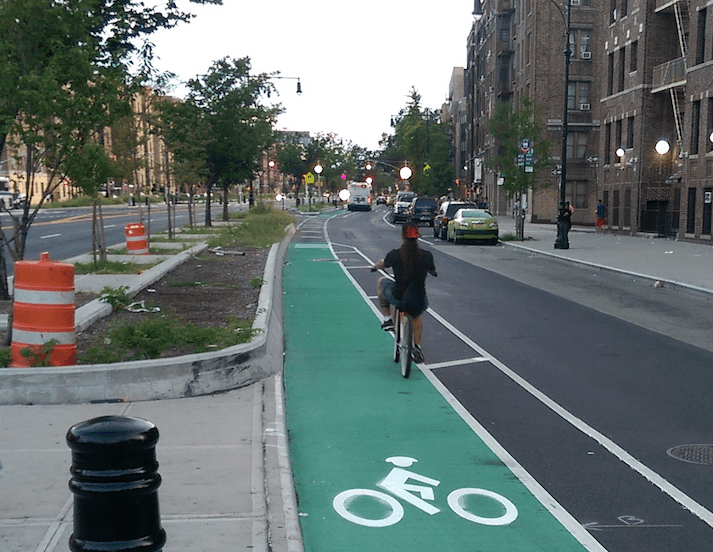David Shorr serves as an alderperson on the city council in Stevens Point, Wisconsin and was at the center of a rancorous battle over a road diet on Stanley Street for his first two years in office. He and his co-author, Kathleen Sullivan, offered this list of lessons learned for communities across the country engaged in similar conflicts.

There are countless articles about why road diets are so controversial in US communities, but fewer resources on how to actually puncture the political and cultural arguments that often shape the debate.
In our latest paper, we argue that in most cases, we must treat such conflicts as a political obstacle to be overcome, rather than substantive concerns that can be addressed via public engagement and bridge-building.
Here are the seven key takeaways from our case study of the Stanley Street road diet in Stevens Point.
1. A Complete Streets plan does not equal community support for complete streets
Despite the contentious battle over slimming down Stanley Street, some might be surprised to learn that Stevens Point already had many of the key markers of a bicycle- and pedestrian-friendly community: a detailed county bike-ped plan; League of American Bicyclists bronze status; a declared commitment to Vision Zero; and an approved $400,000 TAP grant for 13 miles of new bicycle infrastructure street markings. But as David quickly learned, these indicators were deceptive — not signs the whole community was actually ready to divvy up the right of way for the benefit of all users. The real test came when we actually challenged car-dominance by redesigning a main arterial like Stanley Street, whose re-striping was debated in the community for two full years even after the Transportation Alternatives grant with much more extensive changes had been approved unanimously by the council.
2. Recognize when you need a ‘policy change through perseverance’ strategy
Road diet debates often run so hot because they’ve become proxies for local community attitudes about broader forces of societal change. For the most rabid opponents of road diets lane conversion proposals serve as convenient symbols of change rather than genuine threats or disruptions to their lives. As a result, they’re highly unlikely to be persuaded or mollified.
In this situation, the only course left to advocates is what we call a “policy change through perseverance” strategy: assembling a persuasive case, creating policy momentum, and pushing through the resistance all the way to the finish line.
Here are four signs that your battle could benefit from a perseverance strategy:
- Opponents who inflate their political strength through hyperbolic critiques, bold claims about general public sentiment, and having a high profile in the debate.
- A base of support visible and active enough to undercut their claims about the unpopularity of the proposed change, ready to mobilize for key deliberations and votes.
- A solid core of advocates as well as elected decision-maker champions to press the case all the way to the finish line.
- A strong substantive case to refute the counter-advocacy’s caricature of what advocates are proposing.
3. Always name your opponents’ game
Our interest in this advocacy approach led us to explore a range of literature on counter-advocacy and strong practices for how to deal with opponents. One resource, from the University of Kansas Center for Community Health and Development, recommended that advocates not only consistently push back against their opponents’ messages, but also highlight whichever underlying gambit they’re using to seek advantage.
In the Stanley Street case, for instance, the mayor of Stevens Point tried to short-circuit the previous 18 months’ deliberation with an alternative proposal just weeks before the council was to make its decision. David only learned of the University of Kansas framework much later, but his response was right out of its playbook: He insisted that despite the mayor’s attempt to shift the agenda, the road diet was still the question on the table.
4. Expect opponents to be loud and inconsistent — but their bark is worse than their bite
The Stanley Street road diet scrambled typical the political/partisan divides — as local issues often do. David and his city council colleagues heard skeptical views from left, right, and center. But it was the most strident opponents whose voices drowned out the others, and they often echoed the populism of recent times.
Most telling was their claim that the importance of maintaining road space for drivers was so widely supported that it didn’t even need to be debated. As the battle dragged on, the opposition made countless statements at public meetings, collected loads of petition signatures, and rallied endless Facebook commenters to speak out — and then pointed to these ‘wins’ as they criticized road diet supporters for continuing to push the proposal rather than giving up the fight.
But ultimately, the loudest opponents’ posturing as self-appointed spokespeople for majority was revealed as hollow. Despite the opposition’s boisterous displays of emphemeral “support,” not one of the anti-road diet candidates in Stevens Point who later ran against incumbent councilmembers actually won at the ballot box. With a bark much worse than their bite, they were only able to inflict temporary political pain.
5. Think before you mobilize
Road diet opponents indeed collected more petitions and put up more yard signs than road diet supporters in Stevens Point — partly because proponents chose not to compete on that turf. A policy change through perseverance strategy calls for a more subdued approach, focusing on media work and one-to-one conversations to build a solid base of road diet proponents who will show up when they’re needed most. As one of the advocates we interviewed put it:
When that final Stanley Street meeting was held for the council vote, tons of people came out of the woodwork in support of the road diet [including] people I didn’t know. People I hadn’t even heard of. Some people I did know, but didn’t know they were very adamant about getting a road diet.
6. Be the ones to set the terms of the debate
Whenever proponents of change can manage to set the terms of debate with their preferred framing, the policy battle is partly won. In Stevens Point, advocates posed a simple question to the community— whether Stanley was a highway or a neighborhood street — and made a strong case that the experience of living, walking, and shopping in the neighborhood was more important than the ability to drive through as fast as possible.
When the final public meeting was held and the Council voted, their success in framing the issue was evident in the remarks of community residents and council members alike. Without any coordinated effort, numerous speakers at that meeting highlighted the street-versus-highway theme.
7. Keep your eyes on the other side of the finish line.
If advocates push all the way through to a vote by decisionmakers, they have a good chance of not only achieving the desired outcome but also demonstrating the benefits of road diets.
Despite some opponents’ claims that the complete streets ideas adopted by countless other communities won’t work in their town, most often they do. In Stevens Point, the Stanley Street battle paved the way politically for the TAP grant’s full 13 miles of bicycle infrastructure, and all of that re-striping made good on the community’s commitment to streets that pedestrians, bike users, and drivers can truly share. It also earned the town silver status from the League of American Bicyclists. As for road diet opponents and their dire predictions, our study found that some of the more honest ones ultimately copped to their error.
Whenever an advocate picks a policy change they want to pursue, it’s always wise to start with an honest assessment of their chances of success and what they’d be up against. The strategy of policy change through perseverance offers a way to overcome high-decibel opposition, by not taking their ‘voice of the people’ pose at face value and staying the course.
David Shorr and Kathleen Sullivan are evaluation consultants who specialize in assessing non-profits’ advocacy and policy change work.






